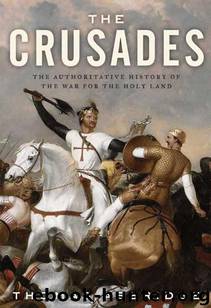The Crusades: The Authoritative History of the War for the Holy Land by Thomas Asbridge

Author:Thomas Asbridge [Asbridge, Thomas]
Language: eng
Format: epub, mobi
Tags: Non-Fiction, History, bought-and-paid-for, Religion
ISBN: 9780060787288
Publisher: Ecco
Published: 2010-03-09T05:00:00+00:00
Hiatus
The coming of winter in December 1189 brought a further lull in the siege. Faced with roughening seas and lacking access to the safety of Acre’s inner harbour, the Latin fleet was forced to sail north to Tyre and beyond in search of shelter. Conrad of Montferrat also returned to Tyre. Worsening weather forced a lull in hostilities as rain turned the ground between the crusaders’ trenches and Saladin’s camp at al-Kharruba to mud, across which it was impractical to launch attacks. The sultan sent the bulk of his troops home, remaining in person, while the Franks hunkered down to wait out the season, hoping to survive the predations of disease and hunger, devoting their energy to the construction of siege engines.
According to his confidant, Baha al-Din, Saladin now recognised ‘how much importance the Franks…attached to Acre and how it was the target at which all their determined plans were directed’. The decision to winter outside the city indicates that the sultan now regarded it as the war’s critical battleground. He may have lacked the nerve for an all-out assault on the crusader camp earlier that autumn, but at least he did show a new, steadfast determination to persevere with the campaign. Having spent the two years that followed Hattin scooping up easy conquests, avoiding drawn-out confrontations, he evidently decided that a line must be drawn at Acre and the Latin advance into Palestine halted in its tracks.
Knowing full well the devastation that would be rained upon Acre come spring, the sultan set about ‘[pouring in] sufficient provisions, supplies, equipment and men to make him feel confident that it was secure’. It was probably at this point that Saladin installed Abu’l Haija the Fat as the city’s military commander, alongside Qaragush. Even the crusaders were impressed by these measures, with one later commenting that ‘never was there a castle nor city that had so many arms, such defence, such provision of food, at such expense’. Amid the flurry of activity, the sultan suffered a grave personal loss when his close friend and shrewd counsellor Isa died of illness on 19 December 1189.31
The long months of stalemate were not solely the domain of grim-eyed exchanges and frenetic preparation. The winter afforded the first opportunities for fraternisation and the blossoming of a familiarity that would remain an undercurrent of the campaign. One of the last Latin ships to arrive in 1189 had carried a different breed of reinforcement: ‘300 lovely Frankish women, full of youth and beauty, assembled from beyond the sea [to offer] themselves for sin’. Saladin’s secretary, Imad al-Din, took a certain scandalised pleasure in describing how these prostitutes, having set up shop outside Acre, ‘brought their silver anklets up to touch their golden earrings [and] made themselves targets for men’s darts’, but noted with evident disgust that some Muslims also ‘slipped away’ to partake of their charms.
Another Muslim eyewitness noted that the Christian and Muslim enemies eventually ‘got to know one another, in that both sides would converse and leave off fighting.
Download
The Crusades: The Authoritative History of the War for the Holy Land by Thomas Asbridge.mobi
This site does not store any files on its server. We only index and link to content provided by other sites. Please contact the content providers to delete copyright contents if any and email us, we'll remove relevant links or contents immediately.
| Africa | Americas |
| Arctic & Antarctica | Asia |
| Australia & Oceania | Europe |
| Middle East | Russia |
| United States | World |
| Ancient Civilizations | Military |
| Historical Study & Educational Resources |
The Radium Girls by Kate Moore(10923)
The Templars by Dan Jones(4197)
100 Deadly Skills by Clint Emerson(4090)
Rise and Kill First by Ronen Bergman(4026)
The Doomsday Machine by Daniel Ellsberg(3742)
The Rape of Nanking by Iris Chang(3530)
Killing England by Bill O'Reilly(3466)
Hitler in Los Angeles by Steven J. Ross(3450)
Stalin by Stephen Kotkin(3094)
12 Strong by Doug Stanton(3064)
Hitler's Monsters by Eric Kurlander(2740)
Darkest Hour by Anthony McCarten(2655)
Blood and Sand by Alex Von Tunzelmann(2615)
The Art of War Visualized by Jessica Hagy(2424)
Hitler's Flying Saucers: A Guide to German Flying Discs of the Second World War by Stevens Henry(2305)
The Code Book by Simon Singh(2222)
The Second World Wars by Victor Davis Hanson(2140)
Babylon's Ark by Lawrence Anthony(2077)
Tobruk by Peter Fitzsimons(2068)
